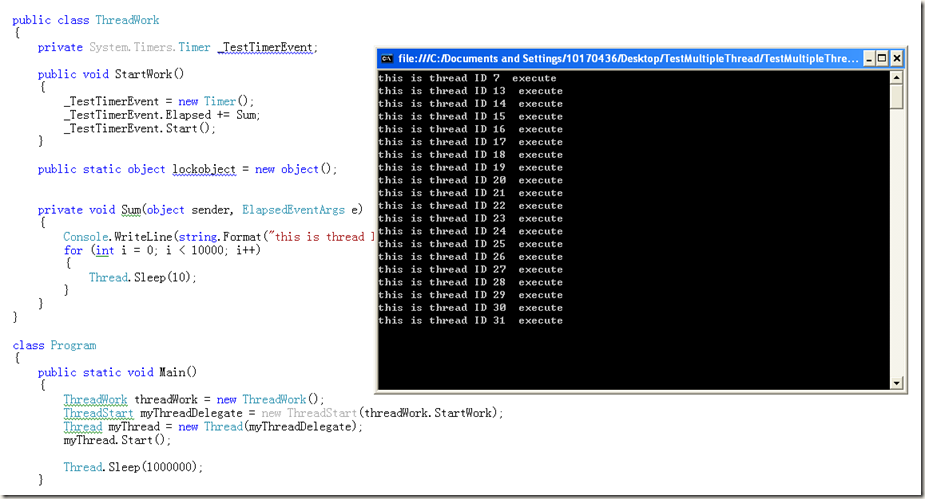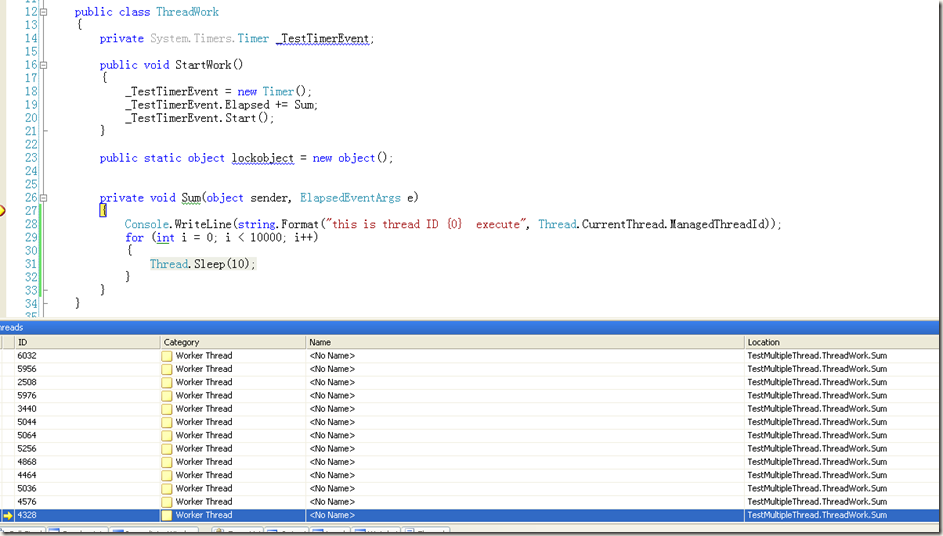.NET System.Timers.Timer的原理和使用(开发定时执行程序)
概述(来自MSDN)
Timer 组件是基于服务器的计时器,它使您能够指定在应用程序中引发 Elapsed 事件的周期性间隔。然后可以操控此事件以提供定期处理。例如,假设您有一台关键性服务器,必须每周 7 天、每天 24 小时都保持运行。可以创建一个使用 Timer 的服务,以定期检查服务器并确保系统开启并在运行。如果系统不响应,则该服务可以尝试重新启动服务器或通知管理员。
基于服务器的 Timer 是为在多线程环境中用于辅助线程而设计的。服务器计时器可以在线程间移动来处理引发的 Elapsed 事件,这样就可以比 Windows 计时器更精确地按时引发事件。
基于 Interval 属性的值,Timer 组件引发 Elapsed 事件。可以处理该事件以执行所需的处理。例如,假设您有一个联机销售应用程序,它不断向数据库发送销售订单。编译发货指令的服务分批处理订单,而不是分别处理每个订单。可以使用 Timer 每 30 分钟启动一次批处理。
注意
当 AutoReset设置为false时,Timer只在第一个Interval过后引发一次Elapsed事件。若要保持以Interval时间间隔引发 Elapsed 事件,请将AutoReset设置为true。
Elapsed事件在ThreadPool线程上引发。如果Elapsed事件的处理时间比Interval长,在另一个hreadPool线程上将会再次引发此事件。因此,事件处理程序应当是可重入的。
注意
在一个线程调用 Stop 方法或将 Enabled 属性设置为 false 的同时,可在另一个线程上运行事件处理方法。这可能导致在计时器停止之后引发 Elapsed 事件。Stop 方法的示例代码演示了一种避免此争用条件的方法。
如果和用户界面元素(如窗体或控件)一起使用 Timer,请将包含有 Timer 的窗体或控件赋值给SynchronizingObject 属性,以便将此事件封送到用户界面线程中。 Timer 在运行时是不可见的。
几点说明
1 | private System.Timers.Timer _TestTimerEvent= new Timer(); |
1 | |
1、默认的周期是0.1秒执行一次;
2、AutoReset的初始值为true.
3、它的timer机制和System.Threading.Timer 原理是一样的。
4、每次周期(Timer)运行一次会新起一个线程。
5、如果Elapsed事件的处理时间比Interval长,它每个周期执行都会新起一个线程,这个线程的执行时间不受interval的限定,可以比interval长,因为一个新周期执行,又会新起一个线程,Timer起的线程周期就是事件处理时间。
我们来看它的实现代码.(.net framework 提供的).
1 2 3 4 5 6 7 8 9 10 11 12 13 14 15 16 17 18 19 20 21 22 23 24 25 26 27 28 29 30 31 32 33 34 35 36 37 38 39 40 41 42 43 44 45 46 47 48 49 50 51 52 53 54 55 56 57 58 59 60 61 62 63 64 65 66 67 68 69 70 71 72 73 74 75 76 77 78 79 80 81 82 83 84 85 86 87 88 89 90 91 92 93 94 95 96 97 98 99 100 101 102 103 104 105 106 107 108 109 110 111 112 113 114 115 116 117 118 119 120 121 122 123 124 125 126 127 128 129 130 131 132 133 134 135 136 137 138 139 140 141 142 143 144 145 146 147 148 149 150 151 152 153 154 155 156 157 158 159 160 161 162 163 164 165 166 167 168 169 170 171 172 173 174 175 176 177 178 179 180 181 182 183 184 185 186 187 188 189 190 191 192 193 194 195 196 197 198 199 200 201 202 203 204 205 206 207 208 209 210 211 212 213 214 215 216 217 218 219 220 221 222 223 224 225 226 227 228 229 230 231 232 233 234 235 236 237 238 239 240 241 242 243 244 245 246 247 248 249 250 251 252 253 254 255 256 257 258 259 260 261 262 263 264 265 266 267 268 269 270 271 272 273 274 275 276 277 278 279 280 281 282 283 284 285 286 287 288 289 290 291 292 293 294 295 296 297 298 299 300 301 302 303 304 305 306 307 308 309 310 311 312 313 314 315 316 317 318 319 320 321 322 323 324 325 326 327 328 329 330 331 332 333 334 | //------------------------------------------------------------------------------ // <copyright file="Timer.cs" company="Microsoft">// Copyright (c) Microsoft Corporation. All rights reserved.// </copyright>//----------------------------------------------------------------------------- namespace System.Timers { using System.Runtime.InteropServices; using System.Security; using System.Security.Permissions; using System.Threading; using System.ComponentModel; using System.ComponentModel.Design; using System; using Microsoft.Win32; using Microsoft.Win32.SafeHandles; /// <devdoc> /// <para>Handles recurring events in an application.</para> /// </devdoc> [ DefaultProperty("Interval"), DefaultEvent("Elapsed"), HostProtection(Synchronization=true, ExternalThreading=true) ] public class Timer : Component, ISupportInitialize { private double interval; private bool enabled; private bool initializing; private bool delayedEnable; private ElapsedEventHandler onIntervalElapsed; private bool autoReset; private ISynchronizeInvoke synchronizingObject; private bool disposed; private System.Threading.Timer timer; private TimerCallback callback; private Object cookie; /// <devdoc> /// <para>Initializes a new instance of the <see cref='System.Timers.Timer'/> class, with the properties /// set to initial values.</para> /// </devdoc> public Timer() : base() { interval = 100; enabled = false; autoReset = true; initializing = false; delayedEnable = false; callback = new TimerCallback(this.MyTimerCallback); } /// <devdoc> /// <para> /// Initializes a new instance of the <see cref='System.Timers.Timer'/> class, setting the <see cref='System.Timers.Timer.Interval'/> property to the specified period. /// </para> /// </devdoc> public Timer(double interval) : this() { if (interval <= 0) throw new ArgumentException(SR.GetString(SR.InvalidParameter, "interval", interval)); int i = (int)Math.Ceiling(interval); if( i < 0) { throw new ArgumentException(SR.GetString(SR.InvalidParameter, "interval", interval)); } this.interval = interval; } /// <devdoc> /// <para>Gets or sets a value indicating whether the Timer raises the Tick event each time the specified /// Interval has elapsed, /// when Enabled is set to true.</para> /// </devdoc> [Category("Behavior"), TimersDescription(SR.TimerAutoReset), DefaultValue(true)] public bool AutoReset { get { return this.autoReset; } set { if (DesignMode) this.autoReset = value; else if (this.autoReset != value) { this.autoReset = value; if( timer != null) { UpdateTimer(); } } } } /// <devdoc> /// <para>Gets or sets a value indicating whether the <see cref='System.Timers.Timer'/> /// is able /// to raise events at a defined interval.</para> /// </devdoc> //[....] - The default value by design is false, don't change it. [Category("Behavior"), TimersDescription(SR.TimerEnabled), DefaultValue(false)] public bool Enabled { get { return this.enabled; } set { if (DesignMode) { this.delayedEnable = value; this.enabled = value; } else if (initializing) this.delayedEnable = value; else if (enabled != value) { if (!value) { if( timer != null) { cookie = null; timer.Dispose(); timer = null; } enabled = value; } else { enabled = value; if( timer == null) { if (disposed) { throw new ObjectDisposedException(GetType().Name); } int i = (int)Math.Ceiling(interval); cookie = new Object(); timer = new System.Threading.Timer(callback, cookie, i, autoReset? i:Timeout.Infinite); } else { UpdateTimer(); } } } } } private void UpdateTimer() { int i = (int)Math.Ceiling(interval); timer.Change(i, autoReset? i :Timeout.Infinite ); } /// <devdoc> /// <para>Gets or /// sets the interval on which /// to raise events.</para> /// </devdoc> [Category("Behavior"), TimersDescription(SR.TimerInterval), DefaultValue(100d), RecommendedAsConfigurable(true)] public double Interval { get { return this.interval; } set { if (value <= 0) throw new ArgumentException(SR.GetString(SR.TimerInvalidInterval, value, 0)); interval = value; if (timer != null) { UpdateTimer(); } } } /// <devdoc> /// <para>Occurs when the <see cref='System.Timers.Timer.Interval'/> has /// elapsed.</para> /// </devdoc> [Category("Behavior"), TimersDescription(SR.TimerIntervalElapsed)] public event ElapsedEventHandler Elapsed { add { onIntervalElapsed += value; } remove { onIntervalElapsed -= value; } } /// <devdoc> /// <para> /// Sets the enable property in design mode to true by default. /// </para> /// </devdoc> /// <internalonly/> public override ISite Site { set { base.Site = value; if (this.DesignMode) this.enabled= true; } get { return base.Site; } } /// <devdoc> /// <para>Gets or sets the object used to marshal event-handler calls that are issued when /// an interval has elapsed.</para> /// </devdoc> [ Browsable(false), DefaultValue(null), TimersDescription(SR.TimerSynchronizingObject) ] public ISynchronizeInvoke SynchronizingObject { get { if (this.synchronizingObject == null && DesignMode) { IDesignerHost host = (IDesignerHost)GetService(typeof(IDesignerHost)); if (host != null) { object baseComponent = host.RootComponent; if (baseComponent != null && baseComponent is ISynchronizeInvoke) this.synchronizingObject = (ISynchronizeInvoke)baseComponent; } } return this.synchronizingObject; } set { this.synchronizingObject = value; } } /// <devdoc> /// <para> /// Notifies /// the object that initialization is beginning and tells it to stand by. /// </para> /// </devdoc> public void BeginInit() { this.Close(); this.initializing = true; } /// <devdoc> /// <para>Disposes of the resources (other than memory) used by /// the <see cref='System.Timers.Timer'/>.</para> /// </devdoc> public void Close() { initializing = false; delayedEnable = false; enabled = false; if (timer != null ) { timer.Dispose(); timer = null; } } /// <internalonly/> /// <devdoc> /// </devdoc> protected override void Dispose(bool disposing) { Close(); this.disposed = true; base.Dispose(disposing); } /// <devdoc> /// <para> /// Notifies the object that initialization is complete. /// </para> /// </devdoc> public void EndInit() { this.initializing = false; this.Enabled = this.delayedEnable; } /// <devdoc> /// <para>Starts the timing by setting <see cref='System.Timers.Timer.Enabled'/> to <see langword='true'/>.</para> /// </devdoc> public void Start() { Enabled = true; } /// <devdoc> /// <para> /// Stops the timing by setting <see cref='System.Timers.Timer.Enabled'/> to <see langword='false'/>. /// </para> /// </devdoc> public void Stop() { Enabled = false; } private void MyTimerCallback(object state) { // System.Threading.Timer will not cancel the work item queued before the timer is stopped. // We don't want to handle the callback after a timer is stopped. if( state != cookie) { return; } if (!this.autoReset) { enabled = false; } FILE_TIME filetime = new FILE_TIME(); GetSystemTimeAsFileTime(ref filetime); ElapsedEventArgs elapsedEventArgs = new ElapsedEventArgs(filetime.ftTimeLow, filetime.ftTimeHigh); try { // To avoid ---- between remove handler and raising the event ElapsedEventHandler intervalElapsed = this.onIntervalElapsed; if (intervalElapsed != null) { if (this.SynchronizingObject != null && this.SynchronizingObject.InvokeRequired) this.SynchronizingObject.BeginInvoke(intervalElapsed, new object[]{this, elapsedEventArgs}); else intervalElapsed(this, elapsedEventArgs); } } catch { } } [StructLayout(LayoutKind.Sequential)] internal struct FILE_TIME { internal int ftTimeLow; internal int ftTimeHigh; } [DllImport(ExternDll.Kernel32), SuppressUnmanagedCodeSecurityAttribute()] internal static extern void GetSystemTimeAsFileTime(ref FILE_TIME lpSystemTimeAsFileTime); }} // File provided for Reference Use Only by Microsoft Corporation (c) 2007. |
在初始化的时候它的代码实现是这样的.
1 2 3 4 5 6 7 8 9 | public Timer() : base() { interval = 100; enabled = false; autoReset = true; initializing = false; delayedEnable = false; callback = new TimerCallback(this.MyTimerCallback);} |
而如果你是这样的话
1 2 3 4 5 6 7 8 9 10 11 12 | public Timer(double interval) : this() { if (interval <= 0) throw new ArgumentException(SR.GetString(SR.InvalidParameter, "interval", interval)); int i = (int)Math.Ceiling(interval); if( i < 0) { throw new ArgumentException(SR.GetString(SR.InvalidParameter, "interval", interval)); } this.interval = interval; } |
你就需要再设置下AutoReset = True;
我们加载事件的Elapsed的代码实现是这样的.
1 2 3 4 5 6 7 8 9 10 11 12 13 | /// <devdoc> /// <para>Occurs when the <see cref='System.Timers.Timer.Interval'/> has/// elapsed.</para>/// </devdoc>[Category("Behavior"), TimersDescription(SR.TimerIntervalElapsed)] public event ElapsedEventHandler Elapsed { add { onIntervalElapsed += value; } remove { onIntervalElapsed -= value; }} |
对它的基本原理有一定了解后,我们开始写一个简单的实现程序。
1 2 3 4 5 6 7 8 9 10 11 12 13 14 15 16 17 18 19 20 21 22 23 24 25 26 27 28 29 30 31 32 33 34 35 36 37 38 39 40 41 42 43 44 45 46 47 48 | using System;using System.Collections.Generic;using System.Linq;using System.Text;using System.Threading;using Timer = System.Timers.Timer;using System.Timers;namespace TestMultipleThread{ public class ThreadWork { private System.Timers.Timer _TestTimerEvent; public void StartWork() { _TestTimerEvent = new Timer(); _TestTimerEvent.Elapsed += Sum; _TestTimerEvent.Start(); } public static object lockobject = new object(); private void Sum(object sender, ElapsedEventArgs e) { Console.WriteLine(string.Format("this is thread ID {0} execute", Thread.CurrentThread.ManagedThreadId)); for (int i = 0; i < 10000; i++) { Thread.Sleep(10); } } } class Program { public static void Main() { ThreadWork threadWork = new ThreadWork(); ThreadStart myThreadDelegate = new ThreadStart(threadWork.StartWork); Thread myThread = new Thread(myThreadDelegate); myThread.Start(); Thread.Sleep(1000000); } }} |
查看的运行结果是:
我们看下执行的线程数有多少
能说明的一个问题就是在timer每次执行时都会新起一个线程来执行。
作者:spring yang
出处:http://www.cnblogs.com/springyangwc/
本文版权归作者和博客园共有,欢迎转载,但未经作者同意必须保留此段声明,且在文章页面明显位置给出原文连接,否则保留追究法律责任的权利。







【推荐】国内首个AI IDE,深度理解中文开发场景,立即下载体验Trae
【推荐】编程新体验,更懂你的AI,立即体验豆包MarsCode编程助手
【推荐】凌霞软件回馈社区,携手博客园推出1Panel与Halo联合会员
【推荐】轻量又高性能的 SSH 工具 IShell:AI 加持,快人一步
· 记一次 .NET某固高运动卡测试 卡慢分析
· 微服务架构学习与思考:微服务拆分的原则
· 记一次 .NET某云HIS系统 CPU爆高分析
· 如果单表数据量大,只能考虑分库分表吗?
· 一文彻底搞懂 MCP:AI 大模型的标准化工具箱
· 博客园2025新款「AI繁忙」系列T恤上架
· Avalonia跨平台实战(二),Avalonia相比WPF的便利合集(一)
· C# LINQ 快速入门实战指南,建议收藏学习!
· Redis实现高并发场景下的计数器设计
· 上周热点回顾(4.7-4.13)